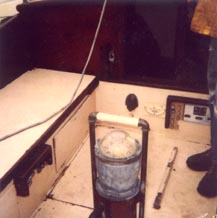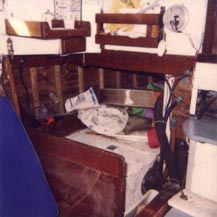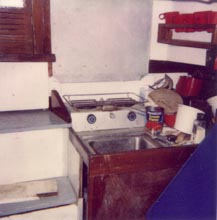 This picture, taken the day after I succumbed to ownership, shows planking on
the starboard side "sprung" because the fasteners had softened too much from
corrosion, and because she had been sitting so long, the keel blocks had
settled, but the stands had not.
This picture, taken the day after I succumbed to ownership, shows planking on
the starboard side "sprung" because the fasteners had softened too much from
corrosion, and because she had been sitting so long, the keel blocks had
settled, but the stands had not.
 There was an overlay of a pattern in the rope work on the compass pedestal,
which did not come out in this Polaroid shot. If you look at the seams at the
bottom of the compass pedestal, you can trace the outline of the engine
hatch. The hatch was half the cockpit floor, but when you lifted it out of
the way you had access to the entire engine and transmission.
There was an overlay of a pattern in the rope work on the compass pedestal,
which did not come out in this Polaroid shot. If you look at the seams at the
bottom of the compass pedestal, you can trace the outline of the engine
hatch. The hatch was half the cockpit floor, but when you lifted it out of
the way you had access to the entire engine and transmission.
 Looking forward, the line coming past the left of the hatch is the sheet for
the self tending jib. The whisker pole on the right rail had its own mounts.
Looking forward, the line coming past the left of the hatch is the sheet for
the self tending jib. The whisker pole on the right rail had its own mounts.
 Inside, she was fairly plain. You can see the lift up ring for the ice box,
and the quarter berth/stowage area. The blue cushion is the settee back, it
lifts up, and you pull a chain from under the cushion and hook it into a ring
set in an over head beam. It was cozy. In the area that would be the "V"
berth on a glass Alberg 30, there was a hanging locker to starboard and
dresser/shelves to port, with a counter top. There was round bowl sink
forward of that and centered in the V was a head. The rest of the area was
chain locker and stowage.
Inside, she was fairly plain. You can see the lift up ring for the ice box,
and the quarter berth/stowage area. The blue cushion is the settee back, it
lifts up, and you pull a chain from under the cushion and hook it into a ring
set in an over head beam. It was cozy. In the area that would be the "V"
berth on a glass Alberg 30, there was a hanging locker to starboard and
dresser/shelves to port, with a counter top. There was round bowl sink
forward of that and centered in the V was a head. The rest of the area was
chain locker and stowage.
 Anyone who's opened the valve a little soon while lighting an alcohol stove
can recognize why a PO put the galvanized sheetmetal up on the bulkhead. The
companionway steps came apart by lifting the individual treads off and
pulling the kickplates up.
Anyone who's opened the valve a little soon while lighting an alcohol stove
can recognize why a PO put the galvanized sheetmetal up on the bulkhead. The
companionway steps came apart by lifting the individual treads off and
pulling the kickplates up.

|
Offshore Sailing
by Bill Seifert with Daniel Spurr
We went to a Windjammers lecture to hear Bill Seifert and I was impressed enough to buy the book on the spot. I've heard a lot of people talk about ways to improve a boat, but I've never heard one person suggest so many good ideas that I hadn't considered. Part of the charm is the specificity of the suggestions. Everyone says you should secure your floorboards, hatchboards and batteries. Bill shows good suggestions on how to do so. The suggestions are very practical for the do-it-yourselfer, too. Many show how to make or adapt inexpensive solutions. Tip #12 on closing the deck blower vents is one that will pay off for me without ever going offshore. I'll implement that one to stop the wintertime storms from finding their way belowdecks. Besides modifications, the book also includes advice for operating offshore, cooking, boat selection, dealing with bureaucracy, and more. Bill Seifert has worked at Tartan, TPI, and Alden Yachts. He's a veteran of many Marion-Bermuda races and now runs his own yacht management company. His tips are born of experience--not of book-learning--and it shows. He obviously knows his stuff. (Note: commissions earned from this link help defray the costs of this website) |
- Carl Alberg
- Alberg's designs
- Anecdotes
- Kurt Hansen
- Wooden Alberg designs
- Alestra or Venture IV or Fortitude
- Katuna
- Serenity or Watusi, a US One Design
- Wemba

